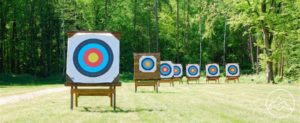Imagine standing on the archery range, bow in hand, ready to release your arrow towards the target. As you draw back, instead of feeling confident and in control, you are overcome with nervousness and anxiety. Your mind races, your heart pounds, and your shot execution falters. This is target panic, a psychological challenge that plagues archers of all levels.
Target panic is a common issue that hinders an archer’s ability to achieve a full anchor position, leading to inconsistent and inaccurate shots. It is caused by a complex interplay of factors such as shot anticipation, fear and anxiety, draw weight, target size, and distance. Overcoming target panic requires a retraining of the brain and a shift in focus towards the shooting process.
In this article, we will explore the causes and factors contributing to target panic and provide practical strategies for overcoming it. By concentrating on form and shot sequence, choosing the right release aid, practicing blind shooting, and talking oneself through the shooting process, archers can rewire their minds to conquer target panic. We will also discuss the importance of relaxation techniques, deep breathing, and the use of a back tension release to improve form and shot execution.
Conquering target panic is not an overnight process, but with time, effort, and the breaking of bad habits, archers can overcome this psychological challenge. By joining the archery community, archers can access exclusive content and support that will aid them in their journey towards target panic-free shooting.
Key Takeaways
- Target panic is a common issue in archery, characterized by nervousness, anxiety, premature hold, premature release, and an inability to achieve full anchor position.
- Factors that contribute to target panic include shot anticipation, fear and anxiety, draw weight, target size, and distance.
- Overcoming target panic requires retraining the brain, focusing on surroundings and feelings during the shooting process, and choosing the right release aid.
- It takes an average of three weeks for beginner archers to overcome target panic.
What is Target Panic?
Target panic refers to a psychological condition commonly experienced in archery, characterized by symptoms such as nervousness, premature hold and release, and an inability to achieve full anchor position. Understanding target panic is crucial for archers as it can have a significant impact on their performance. The signs of target panic, including anxiety and an inability to execute a shot properly, can greatly hinder an archer’s ability to hit the target consistently. This psychological condition is often caused by a need for control and an associated thought process that disrupts the archer’s focus and execution. Target panic can be influenced by various factors such as shot anticipation, fear, draw weight, target size, and distance. By recognizing and addressing target panic, archers can work towards overcoming this challenge and improving their overall performance on the range.
Causes and Factors
Shot anticipation, fear and anxiety, draw weight, target size, and distance are all factors that can contribute to the development of target panic in archery. Understanding these causes is crucial in overcoming this psychological challenge.
- Common symptoms: Target panic is characterized by nervousness, anxiety, premature hold, premature release, and an inability to achieve full anchor position. These symptoms can significantly impact an archer’s performance and accuracy.
- Impact of shot anticipation: Anticipating the shot can lead to a rush of adrenaline and increased anxiety, causing the archer to lose focus and control. This can result in premature release and an inability to execute a smooth, controlled shot.
- Fear and anxiety: Fear of failure or performance anxiety can trigger target panic. The pressure to hit the bullseye or meet certain expectations can create a negative mindset and hinder an archer’s ability to execute their shot effectively.
- Draw weight, target size, and distance: These physical factors can also contribute to target panic. High draw weight can lead to muscle fatigue and less control over the shot. Additionally, shooting at smaller targets or longer distances can increase pressure and anxiety, exacerbating target panic.
By addressing these causes and implementing appropriate strategies, archers can work towards conquering target panic and improving their overall performance.
Strategies for Overcoming
One approach to managing and improving performance in archery involves implementing various strategies that address the psychological aspect of the sport. Breaking bad habits is a crucial step in overcoming target panic. Archers need to retrain their brains and focus on their surroundings and feelings during the shooting process. Concentrating on form and shot sequence can help in developing better shooting habits. Additionally, choosing the right release aid, such as a back tension release, can improve form and shot execution. Another strategy is practicing blind shooting or aiming without shooting, which allows archers to focus on their technique without the pressure of hitting a target. Joining the archery community can also be beneficial as it provides access to exclusive content and support from fellow archers who may have faced similar challenges.
Frequently Asked Questions
How long does it typically take for experienced archers to overcome target panic?
Experienced archers typically take a variable amount of time to overcome target panic, as it depends on individual factors. However, with the right combination of mental techniques, prevention strategies, and effective exercises, archers can significantly reduce the duration of recovery. Professional resources, such as coaching and support from the archery community, can also play a crucial role in overcoming target panic. It is important to note that target panic can have an impact on an archer’s physical performance, making it imperative to address this issue promptly.
Are there any specific exercises or drills that can help in overcoming target panic?
Exercises, drills, prevention techniques, and mental strategies can be utilized to overcome target panic in archery. To address this issue, archers can practice specific exercises such as back tension exercises, blank bale shooting, and controlled shot drills. These exercises focus on improving form, shot execution, and building confidence. Additionally, incorporating mental strategies like visualization, positive affirmations, and self-talk can help archers manage anxiety and maintain focus during the shooting process. By consistently implementing these techniques, archers can gradually overcome target panic and improve their overall performance.
Can target panic affect an archer’s physical performance or only their mental state?
Target panic can have both physical effects and impact an archer’s performance. While target panic is primarily a psychological condition, it can manifest in physical symptoms such as trembling, muscle tension, and erratic movements. These physical effects can significantly affect an archer’s ability to execute their shot accurately and consistently. Additionally, the mental state of an archer experiencing target panic can lead to poor concentration, increased anxiety, and a lack of focus, further compromising their overall performance on the range.
Are there any professional resources or coaches that specialize in helping archers overcome target panic?
Professional resources and coaching are available to help archers overcome target panic, an archery psychological challenge. These resources provide valuable guidance and support in retraining the archer’s mindset and developing effective techniques to manage target panic. Coaches specializing in this area can provide personalized instruction, feedback, and strategies tailored to the individual archer’s needs. Additionally, professional resources such as books, online courses, and workshops offer practical insights and techniques for conquering target panic, enabling archers to improve their mental state and overall performance.
Are there any specific mental techniques or strategies that can be used to prevent target panic from occurring in the first place?
Mental techniques can be employed to prevent target panic in archery. One strategy is to focus on the present moment and avoid getting caught up in thoughts of the outcome. By maintaining a calm and relaxed state of mind, archers can reduce anxiety and perform better. Visualization techniques can also be helpful, where archers imagine themselves executing a perfect shot. Additionally, developing a consistent routine and practicing mindfulness can assist in preventing target panic by promoting a sense of control and focus.
Conclusion
In conclusion, target panic in archery is a psychological challenge that can hinder an archer’s performance. By understanding the causes and factors that contribute to target panic, archers can implement strategies to overcome it. Through retraining the brain, focusing on form and shot sequence, using the right release aid, and practicing relaxation techniques, archers can conquer target panic and improve their shooting skills. Joining the archery community can also provide valuable support and resources in this journey. Remember, breaking bad habits takes time and effort, but with perseverance, target panic can be conquered.












